FLATTERLAND
Ian Stewart, FLATTERLANDIan StewartHigher mathematics and low comedy intersect acutely in this fuzzy follow-up to Edwin Abbott's 1884 classic, Flatland.
Where Abbott's compact fable about a two-dimensional world discomposed by the discovery of a third dimension was a jeu d'esprit
that slyly satirized rigid Victorian society, Stewart's sequel is an episodic ramble through the "flatterland" of modern mathematical theory that begins when teenaged Flatlander Vikki Line, great-great-granddaughter of Abbott's narrator, uses her ancestor's "hysterical document" as a passport to the Mathiverse. Accompanied by a Space Hopper guide, she tours landmarks of the post-Einsteinian universe that include fractal geometry, black holes, cosmic strings and quantum theory. Stewart (The Science of Discworld ) keeps the tone light with incessant puns (a one-sided cow named
"Moobius") and plays on names ("the Hawk King," who presides over a wormhole-ridden realm in the space-time continuum). The many line drawings that illustrate the text are both amusing and instructive. But the terrain Stewart sets out to explore is vast and abstract, and not all of the subjects he covers find a proper social analogue or cultural referent. The result is that lessons Vikki learns on some of the more abstruse principles still have a textbook stuffiness that even the author's Carrollian wit can't leaven. Though perplexing in spots, the tale is ever enchanting, and its user-friendly blend of fiction and nonfiction proves that the comic and cosmic need not be mutually exclusive. (May 1)
Forecast: With advertising in
Scientific
American and the New Yorker and a 50,000-copy first printing, this should be a hit with the literate elite who also appreciate math and science.
closeDetailsReviewed on: 04/02/2001
Genre: Fiction
Open Ebook - 320 pages - 978-0-7867-2328-7
Paperback - 320 pages - 978-0-7382-0675-2
Higher mathematics and low comedy intersect acutely in this fuzzy follow-up to Edwin Abbott's 1884 classic,
Reviewed on: 04/02/2001
Genre: Fiction
Open Ebook - 320 pages - 978-0-7867-2328-7
Paperback - 320 pages - 978-0-7382-0675-2


